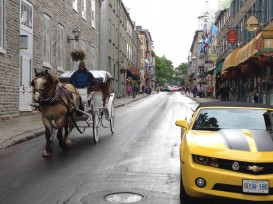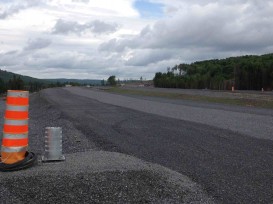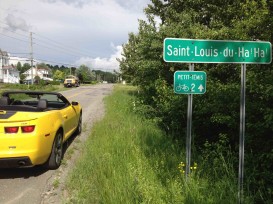Days 21 and 22 on the Trans-Canada, Quebec City, Quebec
Trans-Canada distance: 2,189 km
On the edge of town
Share
Trans-Canada distance: 2,189 km
Actual distance driven: 5,790 km
THEN: (Quebec City) Quebec’s capital city isn’t officially on the Trans-Canada Highway but instead lies about 10 kilometres away on the other side of the St. Lawrence River.

The earliest road-trippers came through here, of course. In 1925, Dr. Perry Doolittle, the founder of the Canadian Automobile Association and known as “the Father of the Trans-Canada Highway,” practised here putting his Model-T Ford on rails by switching over his wheels and crossing on the track of the old railway bridge. You can watch the old video here. Doolittle knew that there were no roads yet built north of Lake Superior and that the only way he was going to drive across Canada that year was by using both road and rail.
Thirteen years previously, Thomas Wilby and Jack Haney crossed the river on the ferry and drove onto the steep cobbled streets of the capital, old even a hundred years ago. Wilby described it in his book “A Motor Tour Through Canada”:
“Quebec City is no place for a self-respecting motor car. On landing from the Levis ferryboat, there is apparently no way of mounting to the Upper Town except by a steep ascent following a winding approach to the ancient gates …

“The car, heavily loaded, realized by some mechanical instinct before we did the absurdity of the unequal contest. It showed the white feather, and half-way up tried to run down again backwards. What it actually succeeded in doing was to come to a full stop athwart the line of traffic, while all Gaul collected on the sidewalks. The situation was ludicrously humiliating …
“I sprang out to lighten the load. “Turn her round and back her up! Quick!” I cried, and ingloriously sought self-effacement among the onlookers. Here we were undertaking the longest road tour ever attempted in Canada, and yet we were unable to climb a paved hill! …
“The car manoeuvred for the right-about-turn while I glared into a shop-window with ostentatious indifference, and decided to go in and buy something for which I had no earthly need. From the inside of the shop, I could see the car creeping laboriously backwards up the hill while the crowd panted along in its wake.”
Is it any wonder that the driver, Haney, loathed his passenger?
NOW: (Riviere du Loup) The short stretch of highway south of here that connects traffic to New Brunswick is a billion-dollar construction project in Quebec. When it’s finally completed in 2018, it will provide a four-lane highway similar in quality and safety to that in New Brunswick.

About half the current Trans-Canada between here and the southern provincial border is still a single lane in each direction, and so has a higher than normal accident rate as vehicles grow impatient to pass slower traffic.
After driving through New Brunswick on excellent road, it’s a lesson to drive alongside the construction and appreciate just how much blasting and leveling has to occur to build a highway. It’s easy to assume, as a driver, that the route has always been fairly flat and straightforward, but when you see the dozers and backhoes among the huge rocks and rubble, smoothing out the way, you realize why road building is so expensive – and such an astonishing feat of engineering. And I’m still far from the mountains.
SOMETHING DIFFERENT … (Saint-Louis-du-Ha! Ha!) Nobody’s quite sure how this small town got its name, but as best I can tell, it’s the only community in North America with an exclamation mark in its title.

The official story says that it’s derived from an old French word for a barrier, because of nearby Lake Temiscouata which blocked the progress of early explorers. Another story says that it came from the local native word “hexcuewaska”, which means “something unexpected” and again describes the nearby lake.
My favourite was told to me by the local tourist guide, who said that when the first explorers saw the lake, they were so taken by its beauty that they couldn’t help but cry out “ha ha!”
Whichever, residents don’t usually use the full name when they’re talking of their town but instead just refer to it as Saint-Louis, hence the Villa Saint-Louis and the Bar Saint-Louis. That’s too bad. I think that if I want a drink, I’d much rather visit a Bar Ha! Ha!